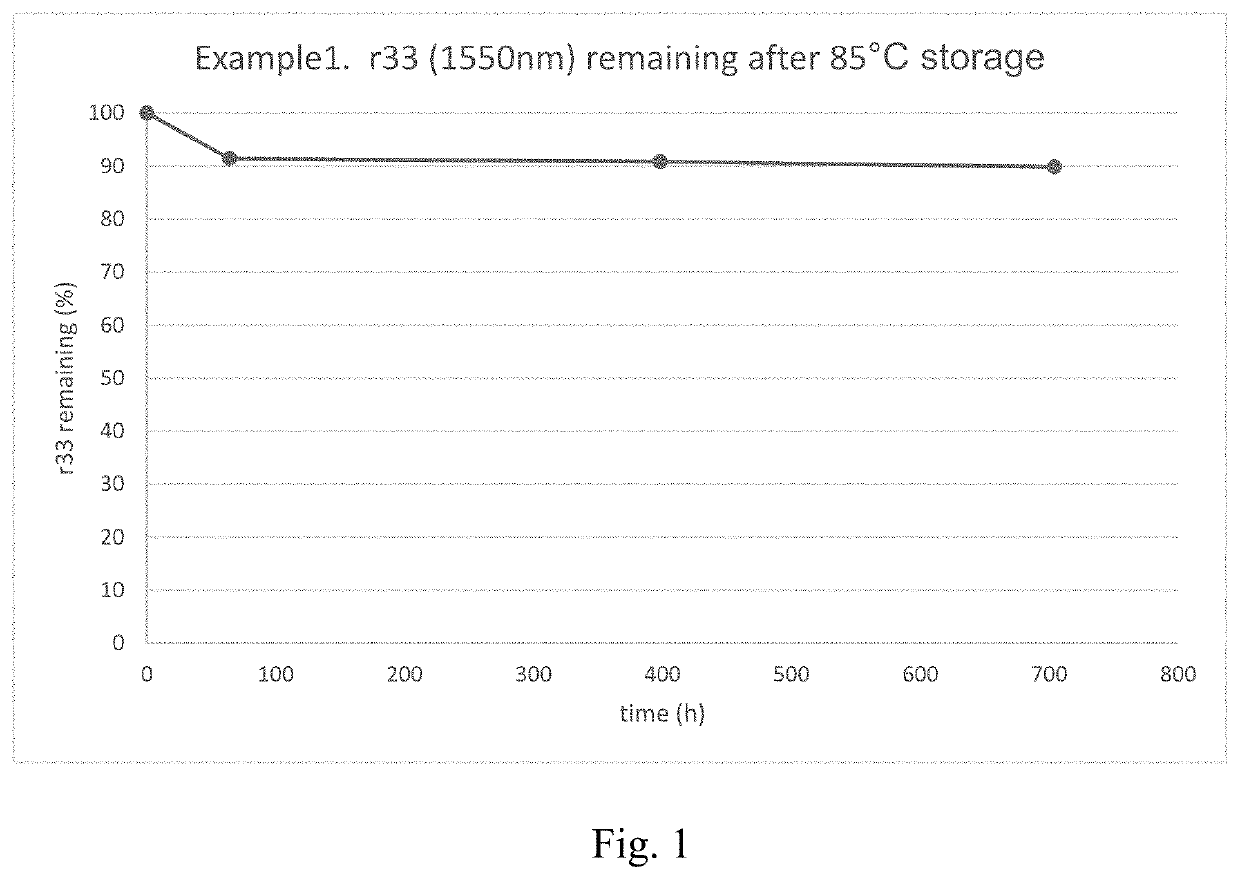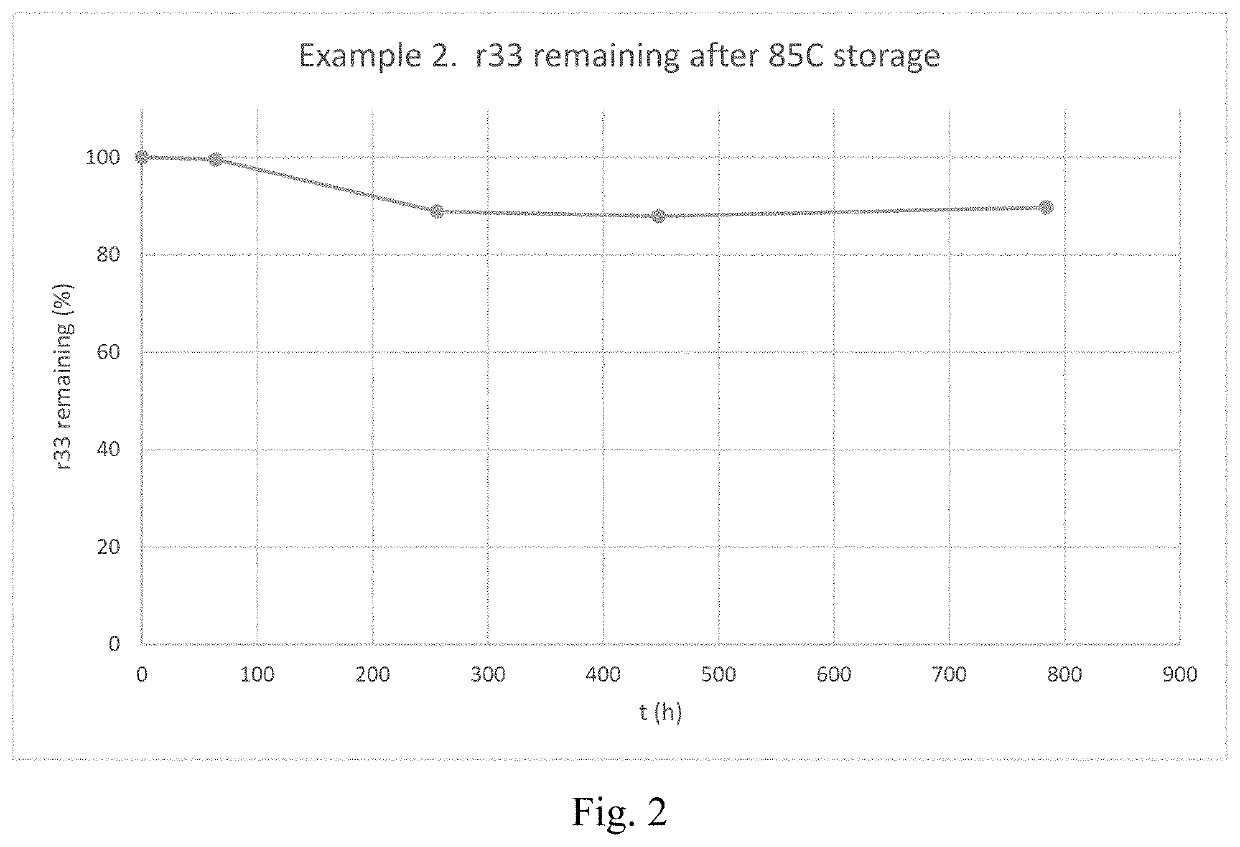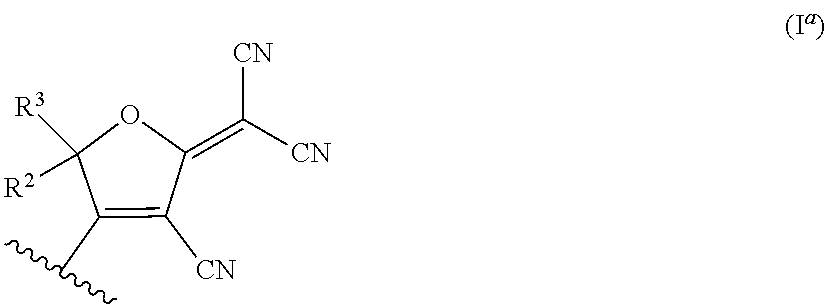Nonlinear Optical Chromophores Having a Diamondoid Group Attached Thereto, Methods of Preparing the Same, and Uses Thereof
- Summary
- Abstract
- Description
- Claims
- Application Information
AI Technical Summary
Benefits of technology
Problems solved by technology
Method used
Image
Examples
synthesis example 1
[0049]Preparation of 2-[4-[(E,3E)-3-[2-(1-adamantylsulfanyl)-3-[(E)-2-[1-(4-methoxyphenyl)-2,2,4,7-tetramethyl-3,4-dihydroquinolin-6-yl]vinyl]-5,5-dimethyl-cyclohex-2-en-1-ylidene]prop-1-enyl]-3-cyano-5-phenyl-5-(trifluoromethyl)-2-furylidene]propanedinitrile is detailed herein.
example 1a
Synthesis of 1-(4-methoxyphenyl)-2,2,4,7-tetramethyl-3,4-dihydroquinoline
[0050]
[0051]A solution of 2,2,4,7-tetramethyl-3,4-dihydro-1H-quinoline (10.0 g, 0.0528 mol) and 1-bromo-4-methoxy-benzene (83.0%, 11.9 g, 0.0528 mol) in toluene (35.0 mL) was sparged with N2 then treated with potassium tert-butoxide (7.71 g, 0.0687 mol), Pd(OAc)2 (0.593 g, 0.00264 mol), and tri-tert-butylphosphine (1.07 g, 0.00528 mol) The flask was fitted with a condenser, and a nitrogen line was inserted. The reaction mixture was heated to 111° C. for 64 hr.
[0052]The reaction mixture was diluted with MeOH then concentrated. The residue was taken up in dichloromethane (“DCM”), then the solids were removed by vacuum filtration. The filtrate was washed sequentially with water and brine, then the organics were dried over MgSO4, filtered, and concentrated. The crude material was purified by normal-phase (“NP”) chromatography (0-50% EtOAc in hexanes). The product fractions were concentrated to afford 1-(4-methoxyph...
example 1b
Synthesis of 1-(4-methoxyphenyl)-2,2,4,7-tetramethyl-3,4-dihydroquinoline-6-carbaldehyde
[0053]
[0054]A solution of 1-(4-methoxyphenyl)-2,2,4,7-tetramethyl-3,4-dihydroquinoline (94.0%, 10.9 g, 0.0346 mol) in DMF (30.0 mL) was sparged with N2 and cooled in an ice bath. POCl3 (7.92 mL, 0.0865 mol) was added slowly via syringe. The mixture stirred on ice for 2 hr, at which time LCMS analysis indicated full conversion to the Vilsmeier adduct (m / z 351) and the aldehyde. The reaction was quenched by addition of water and diluted with DCM, which was stirred at room temp for 16 hr.
[0055]The reaction mixture was extracted with DCM, then the pooled organics were washed with water, dried through a phase separation paper, and concentrated. The crude material was purified by NP chromatography (0-50% EtOAc in hexanes). The product fractions were concentrated to afford 1-(4-methoxyphenyl)-2,2,4,7-tetramethyl-3,4-dihydroquinoline-6-carbaldehyde (10.6 g, 0.0326 mol, yield: 94.3%) as a pale yellow powd...
PUM
 Login to View More
Login to View More Abstract
Description
Claims
Application Information
 Login to View More
Login to View More - R&D
- Intellectual Property
- Life Sciences
- Materials
- Tech Scout
- Unparalleled Data Quality
- Higher Quality Content
- 60% Fewer Hallucinations
Browse by: Latest US Patents, China's latest patents, Technical Efficacy Thesaurus, Application Domain, Technology Topic, Popular Technical Reports.
© 2025 PatSnap. All rights reserved.Legal|Privacy policy|Modern Slavery Act Transparency Statement|Sitemap|About US| Contact US: help@patsnap.com



